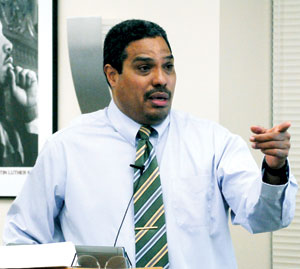
On October 4, Duke University sociology professor Eduardo Bonilla-Silva presented the talk, “It’s REAL! Racism, Discrimination, Color-Blindness, and the Future of Racial Stratification in America” at the Woodrow Wilson School.
Bonilla-Silva believes that racism is alive and well in the U.S. today, and that it has just reared its head in a different way. The author of the book Racism without Racists: Color-Blind Racism and the Persistence of Racial Inequality in the United States, he deals with the future of racial stratification in America beyond the white/black dichotomy.

Bonilla-Silva initially gained visibility and respect in the ’90s by challenging social scientists to reanalyze what he perceived to be their prejudiced perspectives. Today, he speaks of the “new racism” in the U.S.— a subtle, institutional, and hidden racism. He asks how it can be that when surveyed, people of color consistently express a preference for living in mixed-race neighborhoods, yet neighborhood segregation remains extremely pronounced. Indeed, the availability of housing and access to housing is still largely determined based on race: in the U.S. today, 29 percent of Black Americans are likely to pay higher mortgages on the same homes as White Americans; and in almost every area of the U.S., there are issues to accessing services and assets for people of color.
Bonilla-Silva coined a term for what he believes to be at the root of the problem: “Color-Blind Racism.” He defined this as the effort to be completely race neutral in words, policy, and action. It is the view that “the past is the past” and that White Americans are weary of the burden of responsibility from having had ancestors that owned slaves, even when they themselves have never been slave owners. He includes the backlash against affirmative action as a part of color-blind racism—people hiding behind the notion that merit must dominate in selection, ignoring the fact that often the merits of a person of color are ignored or diminished because of the color of their skin. As a result, discrimination has been entrenched and is being promoted by U.S. institutions that use systemic racism and the notion of being color neutral to discriminate legitimately.

He stated most simply, “We are not color-blind. And the more we are race conscious, the more we will be able to overcome issues of race.” He advocates for race-based policies and pushes further for laws that deal with the new-style racism that is hiding behind being color neutral to avoid helping communities of color to rise in this country.
The power of Bonilla-Silva’s talk was that while he is a strong advocate and stated his views with intense conviction, he was funny and open and—most importantly—not shy to open himself to vulnerability. His speech consisted of personal anecdotes and moments where he had been humiliated, mistreated, and judged based on the new racism. He made the audience uncomfortable at times, because he spoke of the unspoken and compelled listeners to refuse to be silent, to speak even if vulnerable, to tell stories with incredulity but without shame, and to allow that discomfort to translate into action. He asserted that discomfort should motivate people to bring up controversial discussions, reject racist policies established under the guise of color-neutral policies, and educate others on the systemic racism that will thrive if ignored. (source: Princeton University)

http://www.theatlantic.com/magazine/archive/2007/06/the-dark-side-of-the-gilded-age/6012/
ReplyDeletehttp://video.google.com/videoplay?docid=6461073450649633844
ReplyDeletehttp://www.csmonitor.com/2007/0522/p16s01-bogn.html
ReplyDelete